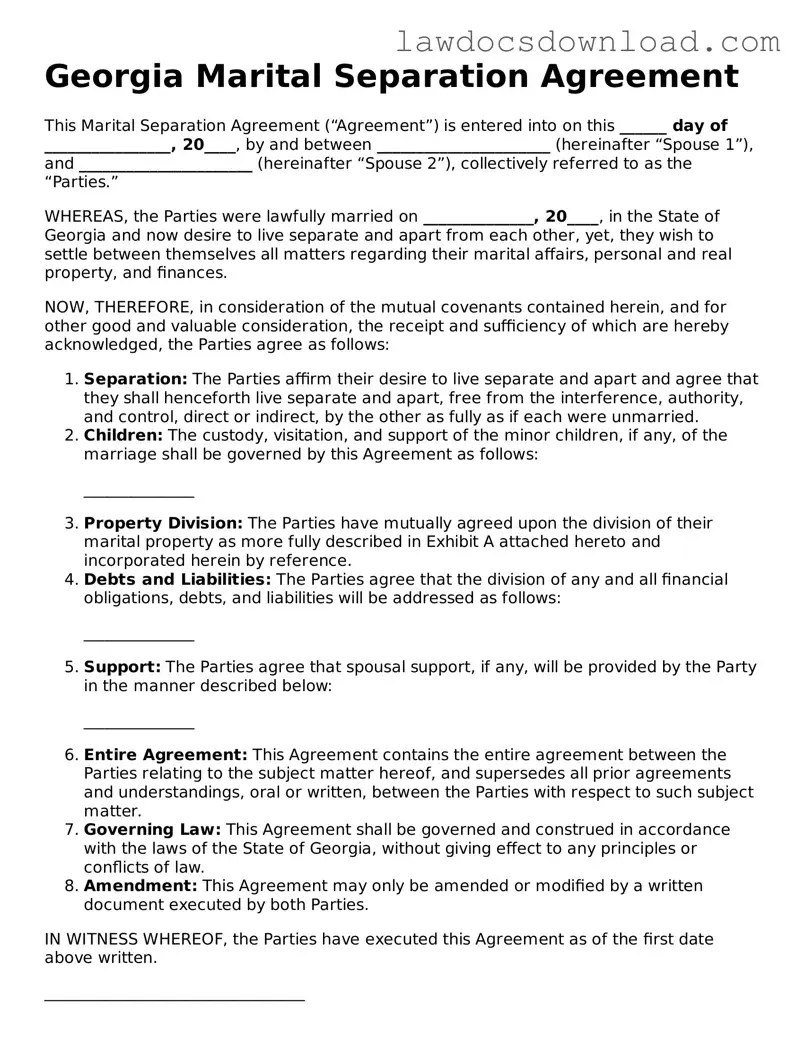The Marital Separation Agreement form closely resembles the Prenuptial Agreement in its function of delineating financial responsibilities and assets division between parties prior to another major legal event. Both documents serve to clarify the division of property, debts, and, in some cases, outline spousal support obligations, thus providing a clear framework that can help avoid potential disputes.
Similarly, the Postnuptial Agreement echoes the essence of a Marital Separation Agreement, as it is executed after marriage but still addresses the distribution of assets, debts, and spousal support in the event of separation or divorce. While a Postnuptial Agreement strengthens the financial understanding between spouses during the marriage, a Marital Separation Agreement specifically addresses these issues in the context of separation.
The Child Custody Agreement shares common ground with the Marital Separation Agreement, particularly in terms of outlining the care and financial support of children post-separation. Both documents aim to ensure the welfare of children involved, detailing custody arrangements, visitation schedules, and support responsibilities, providing a structured approach to maintaining children's well-being amidst parental separation.
A Divorce Settlement Agreement is akin to a Marital Separation Agreement in that it lays out the agreements made by divorcing parties regarding asset division, spousal support, and if applicable, child custody, and support. The key difference is that a Divorce Settlement Agreement is typically used as part of the legal divorce process, whereas a Marital Separation Agreement might be used at the onset of separation, sometimes as a precursor to divorce proceedings.
The Cohabitation Agreement shares similarities with the Marital Separation Agreement by setting out financial arrangements and responsibilities between parties sharing a living arrangement. Although primarily used by couples who are not married, it similarly addresses the management of expenses, property, and the distribution of shared assets in the event the cohabitation ends, much like a separation agreement outlines the division of marital assets and responsibilities.
Alimony Agreements also parallel Marital Separation Agreements in that they specifically focus on the financial support that one partner agrees to provide the other after separation or divorce. Both documents clarify the terms of support to prevent future disputes, setting forth amounts, schedules, and conditions under which financial support will be provided.
A Property Settlement Agreement shares the foundational goal of a Marital Separation Agreement, with a specific focus on dividing property and assets between parties in separation or divorce. This agreement goes into detail about who gets what, from real estate to personal property, ensuring a mutual understanding that can help avoid litigation or further disputes.
Parenting Plans have a distinct resemblance to parts of the Marital Separation Agreement dealing with child custody and support. These plans are comprehensive documents that outline how parents will share responsibilities and time with their children, covering everything from daily schedules to decision-making powers, ensuring that the children's best interests are forefront.
Mediation Settlement Agreements reflect a broader spectrum of conflict resolution but share the preemptive dispute resolution essence of Marital Separation Agreements. Created as a result of mediation processes, these agreements cover various agreed-upon terms between parties to resolve disputes, often including elements found in separation agreements when pertaining to divorce or separation matters.
Lastly, Separation and Property Settlement Agreements, specific to some jurisdictions, are almost identical to Marital Separation Agreements. These documents comprehensively cover the distribution of assets, debts, spousal and child support, and custody arrangements, formulated to protect the interests of both parties involved in a separation or divorce, ensuring a structured and amicable resolution.
